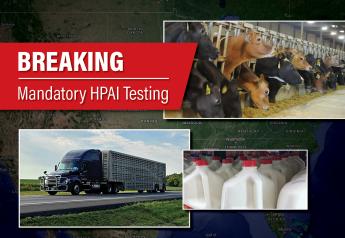Rabobank Foresees Return of Milk Scarcity in Global Markets

International bank also sees improved dairy demand, potential price rise in the coming six months.
Source: Rabobank news release
The global dairy market appears headed for a period of renewed supply scarcity in the next year, Rabobank says in a new report released today.
The impetus for that tightening market comes largely from the supply side, where low milk prices, extreme feed costs and unfavorable weather are expected to slow production growth in export regions to a trickle. That’s according to the report, authored by the bank’s Food & Agribusiness Research and Advisory group.
Rabobank forecasts a reduction in the exportable surplus available from the “Big Seven” export regions (the EU, U.S., Australia, New Zealand, Brazil, Argentina, and Uruguay) in the closing months of 2012 and first half of 2013 – the first such reductions in more than four years.
On the demand side, Rabobank says that some anticipated improvement in the economic position of consumers should provide an impetus to improved demand for dairy. However, the story will be far more compelling in developing regions than the West, where employment and income growth are expected to remain at modest levels.
“The bright light for dairy producers and a fulcrum for recent price recovery on world markets has been the ongoing strength of import demand, and we expect import demand to continue to expand in the coming six months,” Rabobank says.
The bank predicts that, while the economies of China, Southeast Asia, and Middle Eastern/North African countries will move at a slower pace than their 5-year average, incomes will still show real growth, employment will rise, consumers will buy more dairy, and the relative cost of importing versus procuring locally will remain stacked in favor of imports.
“With little excess inventory in the market,” Rabobank says, “the equation becomes simple: any increase in import demand from deficit regions will create supply shortages, and the extent of those shortages will rise with the appetite for imports.”
Rabobank’s third-quarter 2012 report on the global dairy industry further explores these key points:
• The nascent recovery of global dairy commodity prices evident in late Q2 continued through Q3. Price tension was a function of a substantial slowdown in milk production growth in export regions and strong buying from import regions.
• Falling milk production in both the U.S. and EU drove local wholesale prices up rapidly in Q3. The recovery in world market prices was more tepid (4% to 15%), reflecting better supply conditions in Oceania.
• Milk production growth in key export regions will slow to a trickle over the next 12 months, as farmers respond to low milk prices, high feed costs and pockets of unfavorable weather. Even factoring in only fractional consumption growth in the U.S. and EU, this will reduce the volume of surplus product available for international sale from key export regions.
• Assuming a steady rise in demand for imported product, prices will thus need to rise substantially to achieve the required demand rationing to balance the international market. This will likely send prices towards the higher end of our target medium-term trading range (referenced on USD 3,300-3,800/tonne for WMP) in fob Oceania trade in 1H 2013.
• Having heated up earlier, wholesale pricing in the U.S. and EU will see less upside in coming months, until international prices move into alignment as 1H 2013 progresses.
Founded over a century ago, Rabobank is one of the largest banks in the world, with nearly $1 trillion in assets and operations in more than 40 countries, and is among the highest rated private banks by S&P and Moody's. Internationally Rabobank focuses on food and agriculture and in North America it is a premier bank to the food, beverage and agribusiness industry.







